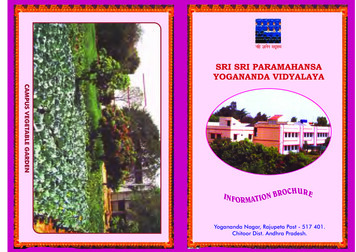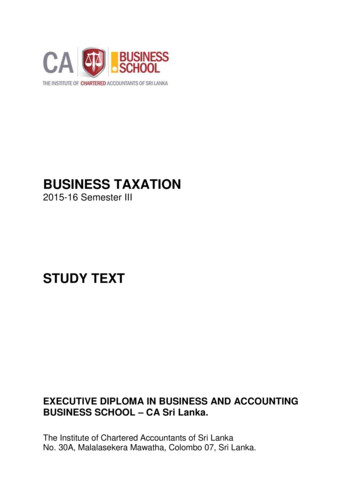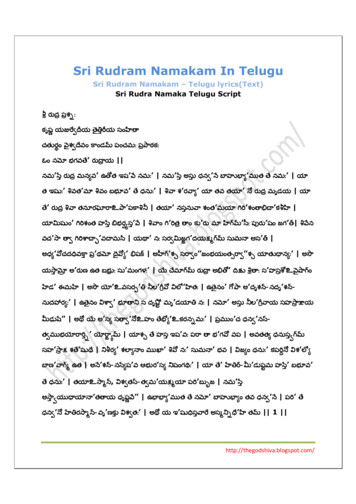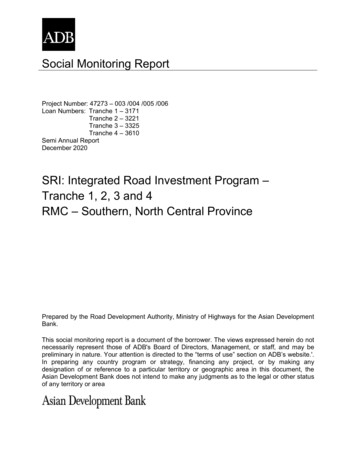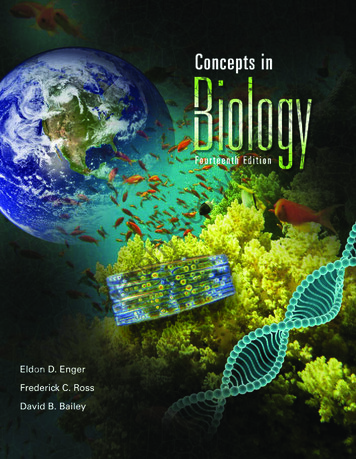
Transcription
bly.eewcs.siphyarsw.awwwmco
www.aswarphysics.wcomeebly.This page intentionally left blank
Concepts ineebly.comBiologyswarphysics.wffourteenth EditionEidon D. Engerw.aFrederick C.RossDavid B. BailerywwDelta CollegeTMeng03466 FM i-xxiv.indd i03/12/10 5:19 AM
TMcomCONCEPTS IN BIOLOGY, FOURTEENTH EDITIONly.Published by McGraw-Hill, a business unit of The McGraw-Hill Companies, Inc., 1221 Avenue of the Americas, New York,NY 10020. Copyright 2012 by The McGraw-Hill Companies, Inc. All rights reserved. Previous editions 2009, 2007, and2005. No part of this publication may be reproduced or distributed in any form or by any means, or stored in a database orretrieval system, without the prior written consent of The McGraw-Hill Companies, Inc., including, but not limited to, in anynetwork or other electronic storage or transmission, or broadcast for distance learning.eebSome ancillaries, including electronic and print components, may not be available to customers outside the United States.This book is printed on acid-free paper.1 2 3 4 5 6 7 8 9 0 QDB/QDB 1 0 9 8 7 6 5 4 3 2 1.wISBN 978–0–07–340346–5MHID 0–07–340346–6w.aswarphysicsVice President, Editor-in-Chief: Marty LangeVice President, EDP: Kimberly Meriwether DavidSenior Director of Development: Kristine TibbettsPublisher: Janice Roerig-BlongExecutive Editor: Michael S. HackettSenior Marketing Manager: Tamara MaurySenior Project Manager: Sandy WilleSenior Buyer: Laura FullerLead Media Project Manager: Judi DavidDesigner: Tara McDermottCover Designer: Greg Nettles/Squarecrow DesignCover Image: Natalia Yakovleva/iStock (cell pattern); Borowa/Dreamstime.com (coral reef); NASA, ESA and others(globe); Melba Photo Agency/PunchStock/RF (microscopy of algae); Mathagraphics/Dreamstime.com (DNA)Senior Photo Research Coordinator: Lori HancockPhoto Research: LouAnn K. WilsonCompositor: S4Carlisle Publishing ServicesTypeface: 10/12 SabonPrinter: Quad/GraphicsAll credits appearing on page C-1 or at the end of the book are considered to be an extension of the copyright page.Library of Congress Cataloging-in-Publication DatawwEnger, Eldon D.Concepts in biology / Eldon D. Enger, Frederick C. Ross, David B. Bailey—14th ed.p. cm.Includes index.ISBN 978–0–07–340346–5—ISBN 0–07–340346–6 (hard copy: alk. paper) 1. Biology.I. Ross, Frederick C. II. Bailey, David B. III. Title.QH308.2.C66 2012570—dc222010030158www.mhhe.comeng03466 FM i-xxiv.indd ii03/12/10 5:20 AM
CHAPTER 24 Materials Exchange in the BodycomMeet the Authorscs.weebly.Eldon D. Enger (Center)Eldon D. Enger is a professor emeritus of biology at DeltaCollege, a community college near Saginaw, Michigan. Hereceived his B.A. and M.S. degrees from the University ofMichigan. Professor Enger has over 30 years of teachingexperience, during which he taught biology, zoology, environmental science, and several other courses, and he was veryactive in curriculum and course development. Professor Engeris an advocate for variety in teaching methodology. He feelsthat if students are provided with varied experiences, they aremore likely to learn. In addition to the standard textbookassignments, lectures, and laboratory activities, his classeswere likely to include writing assignments, student presentation of lecture material, debates by students on controversialissues, field experiences, individual student projects, and discussions of local examples and relevant current events.Professor Enger has been a Fulbright Exchange Teacherto Australia and Scotland, and he received the BergsteinAward for Teaching Excellence and the Scholarly AchievementAward from Delta College.Professor Enger is married, has two sons, and enjoys avariety of outdoor pursuits, such as cross-country skiing, hiking, hunting, fishing, camping, and gardening. Other interestsinclude reading a wide variety of periodicals, beekeeping,singing in a church choir, and preserving garden produce.iiiswarphysiProfessor Ross involved his students in a variety of learningtechniques and was a prime advocate of writing-to-learn. Besideswriting, his students were typically engaged in active learningtechniques, including use of inquiry based learning, the Internet,e-mail communications, field experiences, classroom presentation, and lab work. The goal of his classroom presentations wasto actively engage the minds of his students in understanding thematerial, not just memorization of “scientific facts.”Frederick C. Ross (Right)www.aFred Ross is a professor emeritus of biology at Delta College, acommunity college near Saginaw, Michigan. He received hisB.S. and M.S. from Wayne State University, Detroit, Michigan,and has attended several other universities and institutions.Professor Ross has over 30 years of teaching experience, including junior and senior high school. He has been very active incurriculum development and has developed the courses“Infection Control and Microbiology” and “AIDS and InfectiousDiseases,” a PBS ScienceLine course. He has also been activelyinvolved in the National Task Force of Two Year CollegeBiologists (American Institute of Biological Sciences); N.S.F.College Science Improvement Program (COSIP); Evaluator forScience and Engineering Fairs; Michigan Community CollegeBiologists (MCCB); Judge for the Michigan Science Olympiadand the Science Bowl; and a member of the Topic Outlines inIntroductory Microbiology Study Group of the AmericanSociety for Microbiology.David B. Bailey (Left)David B. Bailey is an associate professor of biology at DeltaCollege, a community college near Saginaw, Michigan. Hereceived his B.A. from Hiram College, Hiram, Ohio, and hisPh.D. from Case Western Reserve University in Cleveland,Ohio. Dr. Bailey has been teaching in classrooms and labs for10 years in both community colleges and 4-year institutions.He has taught general biology, introductory zoology, cellbiology, molecular biology, biotechnology, genetics, andmicrobiology. Dr. Bailey is currently directing Delta’s GeneralEducation Program.Dr. Bailey strives to emphasize critical thinking skills sothat students can learn from each other. Practicing the scientificmethod and participating in discussions of literature, religion,and movies, students are able to learn how to practice appropriate use of different critical thinking styles. Comparing different methods of critical thinking for each of these areas, studentsdevelop a much more rounded perspective on their world.Dr. Bailey’s community involvement includes participating with the Michigan Science Olympiad. In his spare time, heenjoys camping, swimming, beekeeping, and wine-making.iiieng03466 FM i-xxiv.indd iii03/12/10 5:20 AM
ivPART VIPhysiological ProcessesIntroduction 1115PART IICornerstones: Chemistry, Cells,and Metabolism 237swPART IIIw.aMolecular Biology, Cell Division,and Genetics 1518DNA and RNA: The Molecular Basisof Heredity 151Cell Division—Proliferationand Reproduction 173Patterns of Inheritance 201Applications of Biotechnology 225w9w1011PART VThe Origin and Classificationof Life 415physi456The Basics of Life: Chemistry 23Organic Molecules—The Moleculesof Life 45Cell Structure and Function 69Enzymes, Coenzymes, and Energy 99Biochemical Pathways—Cellular Respiration 115Biochemical Pathways—Photosynthesis 135ar23161718.wWhat Is Biology?cs11920212223The Origin of Life and the Evolutionof Cells 415The Classification and Evolutionof Organisms 435The Nature of Microorganisms 455The Plant Kingdom 479The Animal Kingdom 503PART VIPhysiological Processes 53324252627PART IVEvolution and Natural Selection 267The Formation of Speciesand Evolutionary Change 289Ecosystem Dynamics: The Flowof Energy and Matter 311Community Interactions 331Population Ecology 373Evolutionary and Ecological Aspectsof Behavior 391ly.1314eebPART IcomBrief ContentsMaterials Exchange in the Body 533Nutrition: Food and Diet 555The Body’s Control Mechanismsand Immunity 583Human Reproduction, Sex,and Sexuality 613Evolution and Ecology 24712Diversity Within Speciesand Population Genetics247iveng03466 FM i-xxiv.indd iv03/12/10 5:21 AM
Preface xvi2.3comContentsThe Kinetic Molecular Theory and Molecules 28Introduction 112.72.8physiThe Science of Biology 122.933.1w.a3.2wCornerstones: Chemistry, Cells,and Metabolism 23wChemical Reactions 36The Basics of Life: Chemistry 233.3Acids, Bases, and Salts 39Organic Molecules—The Moleculesof Life 45Molecules Containing Carbon 46Carbohydrates 5152Proteins 53The Structure of Proteins 54What Do Proteins Do? 573.4Matter, Energy, and Life 24The Nature of Matter 25Structure of the Atom 25Elements May Vary in Neutrons but Not Protons 25Subatomic Particles and Electrical Charge 25The Position of Electrons 27Oxidation-Reduction Reactions 38Dehydration Synthesis Reactions 38Hydrolysis Reactions 38Phosphorylation Reactions 39Acid-Base Reactions 39Simple Sugars 51Complex CarbohydratesPART II2.12.235Carbon: The Central Atom 47The Complexity of Organic Molecules 48The Carbon Skeleton and Functional Groups 49Macromolecules of Life 49swarWhat Makes Something Alive? 13The Levels of Biological Organizationand Emerging Properties 16The Significance of Biology in Our Lives 17The Consequences of Not UnderstandingBiological Principles 18Future Directions in Biology 212Water: The Essence of Life 34Mixtures and SolutionsScience, Nonscience, and Pseudoscience 8Fundamental Attitudes in Science 8Theoretical and Applied Science 10Science and Nonscience 10Pseudoscience 11The Limitations of Science 121.4.wBasic Assumptions in Science 3Cause-and-Effect Relationships 3The Scientific Method 31.3Ionic Bonds and Ions 32Covalent Bonds 33Why the Study of Biology Is Important 2Science and the Scientific Method 2cs1.11.2What Is Biology? 1Molecules and Kinetic Energy 29Physical Changes—Phases of Matter 31Chemical Changes—Forming New Kindsof Matter 31eeb2.42.52.6PART Ily.The Formation of Molecules 29Nucleic Acids 58DNA 59RNA 603.5Lipids 61True (Neutral) FatsPhospholipids 63Steroids 6561veng03466 FM i-xxiv.indd v03/12/10 5:21 AM
Contents4.1The Development of the Cell Theory 705.5Enzymatic Competition for Substrates 106Gene Regulation 106Inhibition 106Some History 70Basic Cell Types 71Plasma Membrane 76Endoplasmic Reticulum 78Golgi Apparatus 79Lysosomes 79Peroxisomes 79Vacuoles and Vesicles 80Nuclear Membrane 80The Endomembrane System—Interconversionof Membranes 81Energy Converters—Mitochondria and Chloroplasts 814.5Nonmembranous Organelles 834.86.16.26.3Biochemical Pathways—CellularRespiration 115Energy and Organisms 116An Overview of Aerobic CellularRespiration 117The Metabolic Pathways of Aerobic CellularRespiration 119Fundamental Description 119Detailed Description 1216.56.6sww.aEnzymes, Coenzymes,and Energy 99w7.17.27.3eng03466 FM i-xxiv.indd vi7.47.5105Biochemical Pathways—Photosynthesis 135Photosynthesis and Life 136An Overview of Photosynthesis 136The Metabolic Pathways of Photosynthesis 139Fundamental Description 139Detailed Description 141Glyceraldehyde-3-Phosphate: The Productof Photosynthesis 146Cofactors, Coenzymes, and Vitamins 103How the Environment Affects EnzymeAction 103Temperature 104pH 105Enzyme-Substrate ConcentrationMetabolic Processing of MoleculesOther Than Carbohydrates 129Fat Respiration 129Protein Respiration 1307How Cells Use Enzymes 100How Enzymes Speed Chemical ReactionRates 101Aerobic Cellular Respirationin Prokaryotes 126Anaerobic Cellular Respiration 126Alcoholic Fermentation 127Lactic Acid Fermentation 128Prokaryotic and Eukaryotic Cells Revisited 93Enzymes Bind to Substrates 101Naming Enzymes 1035.35.4110Glycolysis 118The Krebs Cycle 118The Electron-Transport System (ETS) 118Diffusion 87Osmosis 89Controlled Methods of Transporting Molecules 90w5.15.266.4Prokaryotic Cell Structure 93Eukaryotic Cell Structure 94The Cell—The Basic Unit of Life 945Biochemical Pathways 109Generating Energy in a Useful Form: ATPElectron Transport 111Proton Pump 112Nuclear Components 86Exchange Through Membranes 87ar4.64.7Enzymatic Reactions Used in ProcessingEnergy and Matter 109physiRibosomes 83Microtubules, Microfilaments, and IntermediateFilaments 84Centrioles 85Cilia and Flagella 85Inclusions 855.6.wCell Size 71The Structure of Cellular Membranes 74Organelles Composed of Membranes 76cs4.24.34.4Cellular-Control Processesand Enzymes 106comCell Structure and Function 69ly.4eebviOther Aspects of Plant Metabolism 146Interrelationships Between Autotrophsand Heterotrophs 14703/12/10 5:22 AM
ContentsPART III9.58.38.4The Control of Protein Synthesis 1619.1arCell Division—Proliferationand Reproduction 173sw99.101010.1Mutations and Protein Synthesis 166Point Mutations 167Insertions and Deletions 168Chromosomal Aberrations 169Mutations and Inheritance 169Cell Division: An Overview 17410.210.310.410.5w.aAsexual Reproduction 174Sexual Reproduction 1749.2The Cell Cycle and Mitosis 17510.6ww9.4eng03466 FM i-xxiv.indd viiControlling Mitosis 179comNondisjunction and ChromosomalAbnormalities 197Patterns of Inheritance 201Meiosis, Genes, and Alleles 202Various Ways to Study Genes 202What Is an Allele? 202Genomes and Meiosis 202The Fundamentals of Genetics 203Phenotype and Genotype 203Predicting Gametes from Meiosis 204Fertilization 204Probability vs. Possibility 205The First Geneticist: GregorMendel 206Solving Genetics Problems 208Modified Mendelian Patterns 213Codominance 213Incomplete Dominance 214Multiple Alleles 215Polygenic Inheritance 216Pleiotropy 217Mitosis—Cell Replication 176Prophase 177Metaphase 177Anaphase 177Telophase 178Cytokinesis 179Summary 179195Single-Factor Crosses 208Double-Factor Crosses 211The G1 Stage of Interphase 175The S Stage of Interphase 176The G2 Stage of Interphase 1769.3Genetic Diversity—The Biological Advantageof Sexual Reproduction 193Mutation 194Crossing-Over 194Segregation 195Independent AssortmentFertilization 197physiControlling Protein Quantity 161Controlling Protein Quality 162Epigenetics 1638.69.9RNA Structure and Function 156Protein Synthesis 157Step One: Transcription—Making RNA 157Step Two: Translation—Making Protein 158The Nearly Universal Genetic Code 1608.5Meiosis I 188Meiosis II 190ly.DNA Structure 154Base Pairing in DNA Replication 154The Repair of Genetic Information 155The DNA Code 155Determination and Differentiation 185Cell Division and Sexual Reproduction 186Meiosis—Gamete Production 188eebDNA and the Importanceof Proteins 152DNA Structure and Function 1549.69.79.8.w8.2DNA and RNA: The Molecular Basisof Heredity 151cs8.1Cancer 181Mutagenic and Carcinogenic Agents 181Epigenetics and Cancer 184Treatment Strategies 184Molecular Biology, Cell Division,and Genetics 1518vii10.7Linkage 218Linkage Groups 218Autosomal Linkage 219Sex Determination 219Sex Linkage 21910.8Other Influences on Phenotype 22003/12/10 5:22 AM
11.4The Genetic Modification of Organisms 23511.513.5The Mechanisms That Affect Genetic DiversityThe Role of Gene Expression 276The Importance of Excess Reproduction 27713.6Genetics in Species and Populations 248The Biological Species Concept 24913.813.9arswEvolution Without Selection—GeneticDrift 281Gene-Frequency Studiesand the Hardy-Weinberg Concept 282Determining Genotype Frequencies 283Why Hardy-Weinberg Conditions Rarely Exist 283Using the Hardy-Weinberg Conceptto Show Allele-Frequency Change 28513.10 A Summary of the Causes of EvolutionaryChange 286Why Genetically Distinct Populations Exist 254w.aAdaptation to Local Environmental Conditions 254The Founder Effect 254Genetic Bottleneck 255Barriers to Movement 2561414.1wGenetic Diversity in Domesticated Plantsand Animals 25614.2Is It a Species or Not? The Evidence 259Human Population Genetics 260Ethics and Human Population Genetics 26214.3eng03466 FM i-xxiv.indd viiiThe Formation of Speciesand Evolutionary Change 289Evolutionary Patterns at the SpeciesLevel 290Gene Flow 290Genetic SimilarityCloning 256Selective Breeding 257Genetic Engineering 257The Impact of Monoculture 257w12.612.712.8Patterns of Selection 280Stabilizing Selection 280Directional Selection 280Disruptive Selection 281How Genetic Diversity Comes About 252Mutations 252Sexual Reproduction 253Migration 253The Importance of Population Size 25412.5The Processes That Drive Selection 278physiDiversity Within Speciesand Population Genetics 24713.7Gene and Allele Frequencies 250Subspecies, Breeds, Varieties, Strains, and Races 25112.4274.wEvolution and Ecology 24712.3The Role of Natural Selectionin Evolution 272Common MisunderstandingsAbout Natural Selection 273What Influences Natural Selection? 274Differential Survival 278Differential Reproductive Rates 279Differential Mate Choice—Sexual Selection 279PART IV12.112.213.4Biotechnology Ethics 243What Are the Consequences? 243Is Biotechnology Inherently Wrong? 2441213.3Stem Cells 240Embryonic and Adult Stem Cells 242Personalized Stem Cell Lines 242The Scientific Concept of Evolution 268The Development of EvolutionaryThought 269Early Thinking About Evolution 269The Theory of Natural Selection 270Modern Interpretations of Natural Selection 270231Genetically Modified Organisms 235Genetically Modified Foods 239Gene Therapy 239The Cloning of Organisms 239Evolution and Natural Selection 267com11.313.113.2Why Biotechnology Works 226Comparing DNA 226DNA Fingerprinting 226Gene Sequencing and the Human Genome Project13ly.11.111.2Applications of Biotechnology 225eeb11Contentscsviii290How New Species Originate 291Speciation by Geographic Isolation 291Polyploidy: Instant Speciation 292Other Speciation Mechanisms 293The Maintenance of Reproductive IsolationBetween Species 29303/12/10 5:22 AM
ContentsEvolutionary Patterns Abovethe Species Level 29516.2The Niche Concept 334The Habitat Concept 334Divergent Evolution 295Extinction 296Adaptive Radiation 296Convergent Evolution 298Homologous or Analogous Structures 299What Is Ecology? 312Biotic and Abiotic Environmental Factors 312Levels of Organization in Ecology 313Trophic Levels and Food Chains 314physi15.2Producers 314Consumers 314Decomposers 31515.316.5Energy Flow Through Ecosystems 31516.6arLaws of Thermodynamics 315The Pyramid of Energy 317The Pyramid of Numbers 317The Pyramid of Biomass 318The Cycling of Materials in Ecosystems—Biogeochemical Cycles 319sw15.416.7Temperate Deciduous Forest 343Temperate Grassland (Prairie) 345Savanna 346Mediterranean Shrublands (Chaparral) 347Tropical Dry Forest 347Desert 348Boreal Coniferous Forest 349Temperate Rainforest 350Tundra 351Tropical Rainforest 353The Relationship Between Elevationand Climate 354Major Aquatic Ecosystems 356Marine Ecosystems 356Freshwater Ecosystems 359Succession 360Primary Succession 361Secondary Succession 363Modern Concepts of Succession and Climax 363Succession and Human Activity 364The Impact of Human Actionson Communities 364Introduced Species 364Predator Control 366Habitat Destruction 367Pesticide Use 368Biomagnification 369w.aThe Carbon Cycle 319The Hydrologic Cycle 321The Nitrogen Cycle 321The Phosphorus Cycle 325Nutrient Cycles and Geologic Time 32515.5Types of Communities 343.wEcosystem Dynamics: The Flowof Energy and Matter 31116.4339cs15.1Competition 336Competition and Natural Selection 336Predation 337Symbiotic Relationships 338Parasitism 338Special Kinds of Predation and ParasitismCommensalism 340Mutualism 341Rates of Evolution 299The Tentative Nature of the EvolutionaryHistory of Organisms 301Human Evolution 301The Genus Ardipithecus 305The Genera Australopithecus and Paranthropus 305The Genus Homo 306Two Points of View on the Origin of Homo sapiens 30615Kinds of Organism Interactions 336com14.716.3ly.14.514.6Niche and Habitat 334eeb14.4ixHuman Use of Ecosystems 326wwThe Conversion of Ecosystems to Human Use 326The Energy Pyramid and Human Nutrition 3281616.1Community Interactions 331The Nature of Communities 332Defining Community Boundaries 332Complexity and Stability 333Communities Are Dynamic 334eng03466 FM i-xxiv.indd ix1717.1Population Ecology 373Population Characteristics 374Gene Flow and Gene Frequency 374Age Distribution 374Sex Ratio 376Population Distribution 377Population Density 37703/12/10 5:22 AM
xContentsReproductive Capacity 378The Population Growth Curve 379The Lag Phase 379The Exponential Growth Phase 379The Deceleration Phase 379The Stable Equilibrium Phase 380Alternate Population Growth Strategies 38017.5Categories of Limiting Factors 381Availability of Raw Materials 381Availability of Energy 381Accumulation of Waste Products 381Interaction with Other Organisms 38217.617.7Carrying Capacity 384Limiting Factors to Human PopulationGrowth 3851818.1The Control of the Human Population—A Social Problem 3881919.119.219.3Interpreting Behavior 39219.419.5The “Big Bang” and the Originof the Earth 419sww.awweng03466 FM i-xxiv.indd xMajor Evolutionary Changesin Early Cellular Life 42419.6The Geologic Timeline and the Evolutionof Life 429An Aquatic Beginning 431Adaptation to a Terrestrial Existence 431398Instinct and Learning in the Same Animal 400Human Behavior 402Selected Topics in Behavioral Ecology 403Communication 404Reproductive BehaviorThe Chemical Evolution of Life on Earth 419The Development of an Oxidizing Atmosphere 424The Establishment of Three Major Domainsof Life 425The Origin of Eukaryotic Cells 426The Development of Multicellular Organisms 429Kinds of Learning 396Habituation 396Association 397Exploratory LearningImprinting 399Insight 40018.518.618.7418The Formation of the First Organic Molecules 420The Formation of Macromolecules 421RNA May Have Been the First Genetic Material 422The Development of Membranes 422The Development of Metabolic Pathways 423The Problem of Anthropomorphism 393Instinctive and Learned Behavior 394The Nature of Instinctive Behavior 394The Nature of Learned Behavior 39618.4Early Thoughts About the Origin of Life 416Current Thinking About the Origin of Life 418The “Big Bang” 419The Formation of the Planet Earth 419Conditions on the Early Earth 419Discovering the Significance of Behavior 392Behavior Is Adaptive 39218.218.3The Origin of Life and the Evolutionof Cells 415An Extraterrestrial Origin for Life on EarthAn Earth Origin for Life on Earth 418Evolutionary and Ecological Aspectsof Behavior 391ar17.8The Origin and Classificationof Life 415physiAvailability of Raw Materials 385Availability of Energy 386Accumulation of Wastes 387Interactions with Other Organisms 388PART Vly.Extrinsic and Intrinsic Limiting Factors 380Density-Dependent and Density-IndependentLimiting Factors 381.wLimits to Population Size 380cs17.4comTerritorial Behavior 407Dominance Hierarchy 408Behavioral Adaptations to Seasonal Changes 409Navigation and Migration 410Social Behavior 411eeb17.217.34052020.1The Classification and Evolutionof Organisms 435The Classification of Organisms 436The Problem with Common Names 436Taxonomy 436Phylogeny 43903/12/10 5:22 AM
ContentsA Brief Survey of the Domainsof Life 44222.10 Plant Responses to Their Environment 498Tropisms 498Seasonal Responses 499Responses to Injury 499The Domain Bacteria 442The Domain Archaea 446The Domain Eucarya 44722.11 The Coevolution of Plants and Animals 500Acellular Infectious Particles 451Viruses 451Viroids: Infectious RNA 452Prions: Infectious Proteins 45221.121.2The Nature of Microorganisms 45523.123.223.323.4What Are Microorganisms? 456The Domains Bacteria and Archaea 45623.5Multicellularity in the Protista 472The Kingdom Fungi 472cs47123.6The Taxonomy of Fungi 473The Significance of Fungi 474What Is a Plant? 480Alternation of Generations 480The Evolution of Plants 481Nonvascular Plants 482ar22.122.222.322.4The Plant Kingdom 479sw22The Moss Life Cycle 482Kinds of Nonvascular Plants 483wRoots 485Stems 485Leaves 486w22.722.8Seedless Vascular Plants 488The Fern Life Cycle 488Kinds of Seedless Vascular Plants 488Seed-Producing Vascular Plants 490Gymnosperms 491Angiosperms 49322.9eng03466 FM i-xxiv.indd xi23.723.823.923.1023.1123.1223.1323.14The Growth of Woody Plants 497Primitive Marine Animals 512Porifera—Sponges 512Cnidaria—Jellyfish, Corals, and Sea Anemones 512Ctenophora—Comb Jellies 513Platyhelminthes—Flatworms 514Nematoda—Roundworms 516Annelida—Segmented Worms 518Mollusca 519Arthropoda 520Echinodermata 520Chordata 522Adaptations to Terrestrial Life 524Terrestrial Arthropods 524Terrestrial Vertebrates 526The Significance of Vascular Tissue 483The Development of Roots, Stems,and Leaves 484w.a22.522.6Marine Lifestyles 511Zooplankton 511Nekton 511Benthic Animals 511physi21.421.5507.wThe Kingdom Protista 464Algae 465Protozoa 468Funguslike ProtistsWhat Is an Animal? 504The Evolution of Animals 505Temperature Regulation 506Body Plans 507Symmetry 507Embryonic Cell LayersBody Cavities 509Segmentation 509Skeletons 510The Domain Bacteria 456The Domain Archaea 46221.3The Animal Kingdom 503eeb2123com20.3ly.20.2xiPART VIPhysiological Processes 5332424.124.2Materials Exchange in the Body 533The Basic Principles of Materials Exchange 534Circulation: The Cardiovascular System 534The Nature of Blood 534The Heart 537Blood Vessels: Arteries, Veins, and Capillaries53903/12/10 5:22 AM
Contents24.324.4The Lymphatic System 541Gas Exchange: The Respiratory System 54225.8Anaerobic and Aerobic Exercise 579Metabolic Changes During AerobicExercise 579Diet and Exercise 579Mechanics of Breathing 543Breathing System Regulation 543Lung Function 544Obtaining Nutrients: The Digestive System 545Kidney Structure 550Kidney Function 5502525.126.2Living Things as Chemical Factories:Matter and Energy Manipulators 556The Kinds of Nutrients and Their Function 55726.6swww574Nutrition Through the Life Cycle 575Infancy 575Childhood 575Adolescence 576Adulthood 576Old Age 577Pregnancy and Lactationeng03466 FM i-xxiv.indd xiiOutput Coordination 599Muscular Contraction 599The Types of Muscle 601The Activities of Glands 602Growth Responses 60226.7The Body’s Defense Mechanisms—Immunity 603Innate Immunity 603Adaptive Immunity 604Immune System Diseases 607Determining Energy Needs 569Eating Disorders 571Obesity 571Bulimia 573Anorexia Nervosa25.7Chemical Detection 595Vision 596Hearing and Balance 597Touch 598w.a25.525.6The Integration of Nervous and EndocrineFunction 593Sensory Input 595physi26.5Dietary Reference Intakes 565The Food Guide Pyramid 565Grains 565Fruits 565Vegetables 568Milk 568Meat and Beans 568Oils 569Exercise 569The Endocrine System 591Endocrine System Function 591Negative-Feedback Inhibitionand Hormones 592ar25.325.426.326.4Carbohydrates 557Lipids 558Proteins 559Vitamins 561Minerals 563Water 564Coordination in MulticellularAnimals 584Nervous System Function 585The Structure of the Nervous System 585The Nature of the Nerve Impulse 586Activities at the Synapse 588The Organization of the CentralNervous System 588Nutrition: Food and Diet 555Diet and Nutrition Defined 556Energy Content of Food 55625.226.1ly.Waste Disposal: The Excretory System 550The Body’s Control Mechanismsand Immunity 583.w24.626eebMechanical and Chemical Processing 546Nutrient Uptake 548Chemical Alteration: The Role of the Liver 549cs24.5Nutrition for Fitness and Sports 578comxii2727.127.2Human Reproduction, Sex,and Sexuality 613Sexuality from Various Points of View 614The Sexuality Spectrum 615Anatomy 615Behavior 61557827.3Components of Human Sexual Behavior 61603/12/10 5:22 AM
ContentsSex Determination and Embryonic SexualDevelopment 617Hormonal Control Methods 634The Timing Method 634Intrauterine Devices (IUD) 635Surgical Methods 635The Sexual Maturation of Young Adults 620The Maturation of Females 620The Maturation of Males 62127.627.727.827.9Spermatogenesis 622Oogenesis, Ovulation, and Menstruation 623The Hormonal Control of Fertility 626Fertilization, Pregnancy, and Birth 628Appendix 1 A-1Appendix 2 A-3Glossary G-1Credits C-1Index I-1Twins 630Birth 63127.10 Contraception 632www.aswarphysics.wBarrier Methods 632Chemical Methods 634com27.527.11 Termination of Pregnancy—Abortion 63627.12 Changes in Sexual Function with Age 636ly.Chromosomal Determination of Sex 617Chromosomal Abnormalities and SexualDevelopment 618Fetal Sexual Development 618eeb27.4xiiieng03466 FM i-xxiv.indd xiii03/12/10 5:22 AM
Edward Jenner and the Controlof Smallpox 18Chapter 2of the ElementsThe Periodic Table26Chapter 8Greenhouse Gases and TheirRelationship to Global Warming 32OUTLOOKS 2.1: Water and Life—The Most CommonCompound of Living Things 37OUTLOOKS 2.2: Maintaining Your pH—HowBuffers Work 41HOW SCIENCE WORKS 2.2:Scientists Unravelingthe Mystery of DNA 152OUTLOOKS 8.1: Life in Reverse—Retroviruses 164OUTLOOKS 8.2: Telomeres 166OUTLOOKS 8.3: One Small Change—One BigDifference! 167.wHOW SCIENCE WORKS 8.1:Chapter 3Organic Compounds: Poisonsto Your Pets! 48OUTLOOKS 3.1: Chemical Shorthand 50OUTLOOKS 3.2: So You Don’t Eat Meat! Howto Stay Healthy 54OUTLOOKS 3.3: What Happens When YouDeep-Fry Food? 63OUTLOOKS 3.4: Fat and Your Diet 64Model 75Cystic Fibrosis—What Isthe Probability? 206OUTLOOKS 10.1: The Inheritance of Eye Color 217OUTLOOKS 10.2: The Birds and the Bees . . . and theAlligators 220HOW SCIENCE WORKS 10.1:Developing the Fluid-MosaicChapter 11swHOW SCIENCE WORKS 4.1:The Concepts of Homeostasisand Mitosis Applied 183HOW SCIENCE WORKS 9.1:Chapter 10arChapter 4Chapter 9physiHOW SCIENCE WORKS 3.1:Solution to Global Energy CrisisFound in Photosynthesis? 137OUTLOOKS 7.1: The Evolution of Photosynthesis 145OUTLOOKS 7.2: Even More Ways to Photosynthesize 147HOW SCIENCE WORKS 7.1:csHOW SCIENCE WORKS 2.1:ly.Chapter 7HOW SCIENCE WORKS 1.1:eebChapter 1comTable of Boxesw.aChapter 5Passing Gas, Enzymes, andBiotechnology 102HOW SCIENCE WORKS 5.1: Don’t Be Inhibited—Keep YourMemory Alive 108wOUTLOOKS 5.1:Chapter 12Chapter 6Your Skin Color, Gene Frequency Changes,and Natural Selection 251OUTLOOKS 12.2: Biology, Race, and Racism 252HOW SCIENCE WORKS 12.1: The Legal Implications of Defininga Species 261HOW SCIENCE WORKS 12.2: Bad Science: A Brief Historyof the Eugenics Movement 263OUTLOOKS 12.1:wWhat Happens When You DrinkAlcohol 123OUTLOOKS 6.2: Souring vs. Spoilage 128OUTLOOKS 6.3: Body Odor and Bacterial MetabolismHOW SCIENCE WORKS 6.1: Applying Knowledge ofBiochemical Pathways 131The First Use of a D
He has taught general biology, introductory zoology, cell biology, molecular biology, biotechnology, genetics, and microbiology. Dr. Bailey is currently directing Delta’s General Education Program. Dr. Bailey strives to emphasize critical thinking skills so that stud

